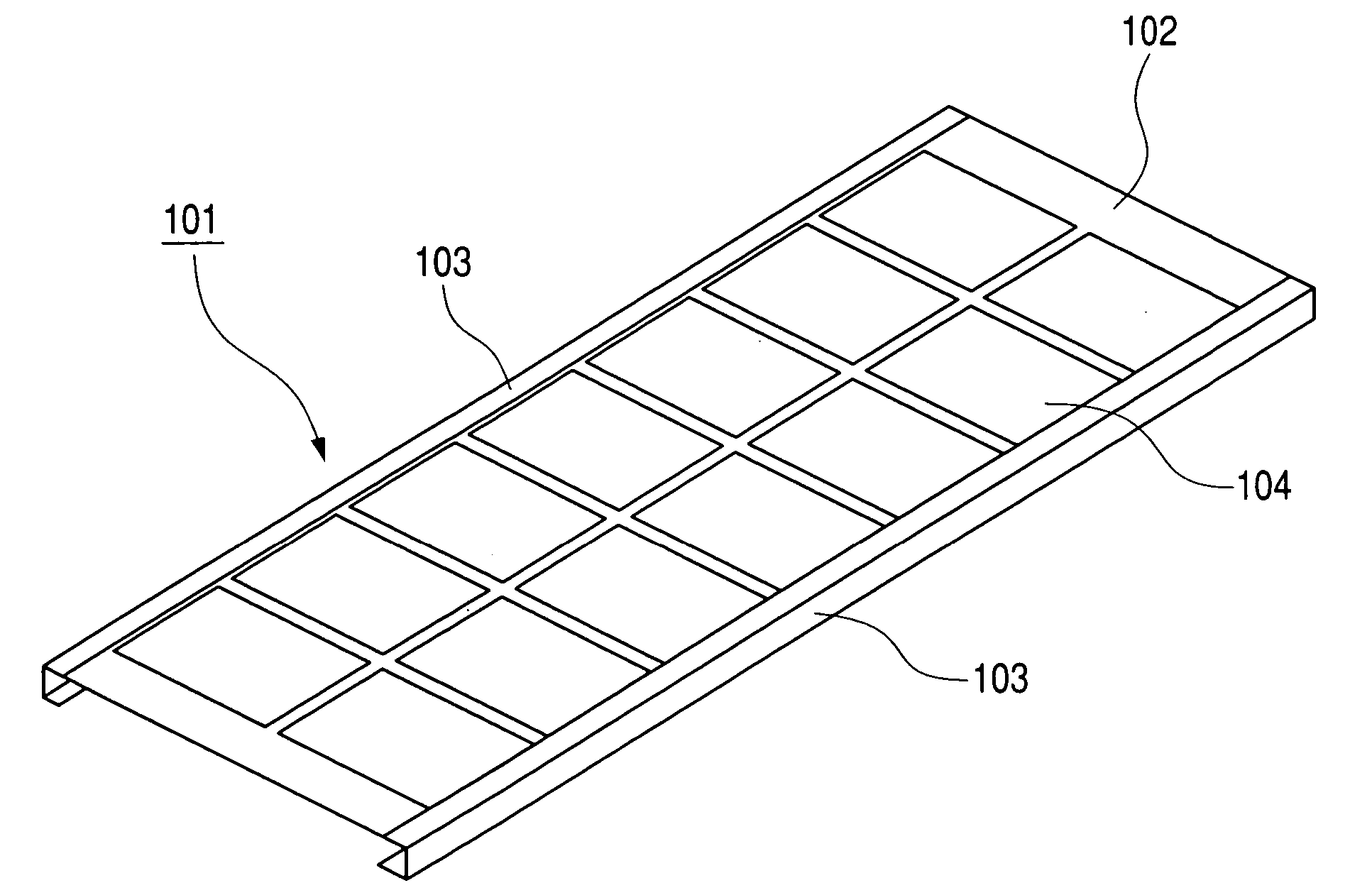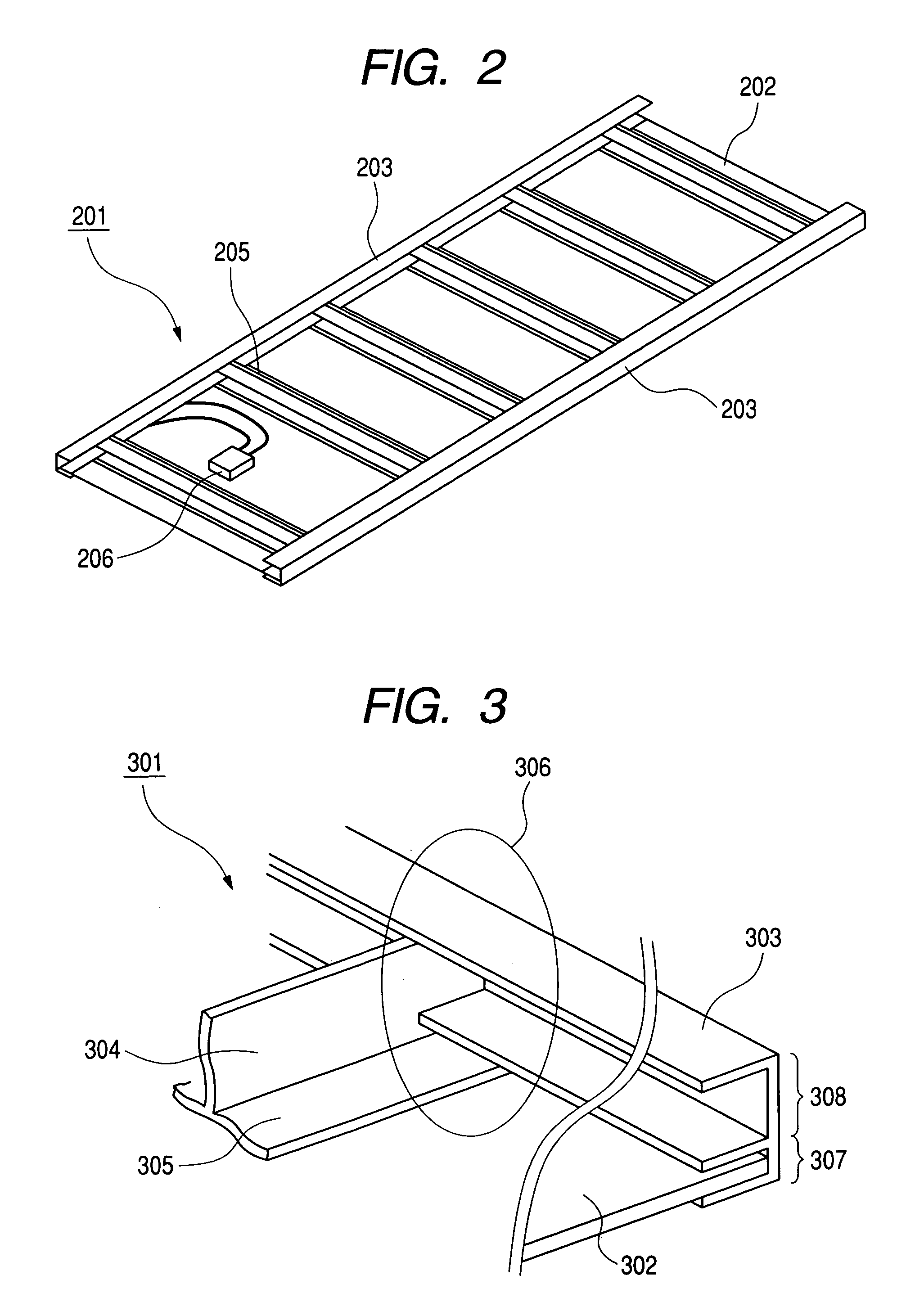Solar cell module and manufacturing method therefor
- Summary
- Abstract
- Description
- Claims
- Application Information
AI Technical Summary
Benefits of technology
Problems solved by technology
Method used
Image
Examples
example 1
[0059] A solar cell module according to Example 1 of the present invention is composed of: a solar cell panel using an amorphous / microcrystalline silicon stacked solar cell that is covered with a covering material consisting of ETFE, EVA and PET, and integrally stacked with a molten Zn55%—AL-based alloy-plated steel plate (Galvalume steel plate); an aluminum frame; and a back member made of a Galvalume steel plate provided on the back side of the solar cell panel. The back member is composed of a joining portion for joining to the back side of the solar cell panel, and a projection portion extending in the direction crossing the aluminum frame. The aluminum frame has a first engaging portion for engaging with the solar cell panel and the joining portion of the back member, and a second engaging portion for engaging with the projection portion of the back member.
[0060]FIG. 4 is a schematic view of the solar cell module according to Example 1 as seen from its light-receiving surface ...
example 2
[0079] A solar cell module according to Example 2 of the present invention is composed of: a solar cell panel using a plurality of amorphous / microcrystalline silicon stacked solar cells covered with a covering material consisting of ETFE, EVA and PET; an aluminum frame; and a back member consisting of a molten Zn55%—Al-based alloy-plated steel plate provided on the back side of the solar cell panel and having a plurality of projection portions formed by bending.
[0080]FIG. 14 is a schematic view of the solar cell module according to Example 2 as seen from its light-receiving surface side. Reference numeral 1401 denotes a solar cell module, 1402 a solar cell panel, 1403 an aluminum frame, 1404 a bending portion of a back member, and 1405 an amorphous / microcrystalline silicon stacked solar cell.
[0081]FIG. 15 is a schematic diagram of the solar cell panel according to Example 2. Reference numeral 1501 denotes a solar cell panel, 1502 an amorphous / microcrystalline silicon stacked solar...
example 3
[0088] A solar cell module according to Example 3 of the present invention is composed of: a solar cell panel using a plurality of amorphous / microcrystalline silicon stacked solar cells covered with a covering material consisting of ETFE, EVA and PET; an aluminum frame; and a back member consisting of a coated zinc steel plate provided on the back side of the solar cell panel and having a plurality of projection portions formed by bending.
[0089]FIG. 19 is a schematic view of the solar cell module according to Example 3 as seen from its non-light-receiving surface side. Reference numeral 1901 denotes a solar cell module, 1902 a solar cell panel, 1903 a back member, 1904 a bending portion of the solar cell panel, and 1905 a junction box.
[0090]FIG. 20 is a schematic view showing the construction of the engaging portion of the back portion engaged with the aluminum frame according to Example 3. Reference numeral 2001 denotes a back member, 2002 a projection portion of the back member,...
PUM
 Login to View More
Login to View More Abstract
Description
Claims
Application Information
 Login to View More
Login to View More - R&D
- Intellectual Property
- Life Sciences
- Materials
- Tech Scout
- Unparalleled Data Quality
- Higher Quality Content
- 60% Fewer Hallucinations
Browse by: Latest US Patents, China's latest patents, Technical Efficacy Thesaurus, Application Domain, Technology Topic, Popular Technical Reports.
© 2025 PatSnap. All rights reserved.Legal|Privacy policy|Modern Slavery Act Transparency Statement|Sitemap|About US| Contact US: help@patsnap.com



